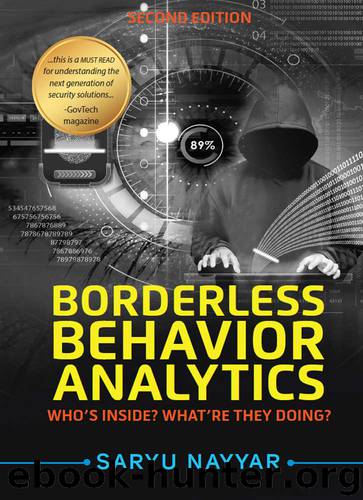Borderless Behavior Analytics - Second Edition: Who's Inside? What're They Doing? by Saryu Nayyar

Author:Saryu Nayyar [Nayyar, Saryu]
Language: eng
Format: epub
Publisher: Ankur Chadda
Published: 2018-04-25T22:00:00+00:00
Perspectives on data lake adoption
While all data lakes are theoretically the same in their function, how organizations use them differs widely. How data lakes are planned, organized and set up is an important consideration for any security leader. One way to look at the variety and model variance is from the inventory management perspective. Target has a physical warehouse; Walmart has a physical warehouse; Amazon has a physical warehouse. Every physical warehouse would have a different way to store their products and manage them, yet it’s essentially the same set of products. Walmart or Target stock their merchandise in their physical stores, with aisles, storerooms, distribution hubs, etc. Amazon, meanwhile, likely has your favorite soap stacked right beside a popular book. Their distribution has an on-demand model, not one consisting of stocking shelves based on projected sales. The products are still the same. It’s just how the physical warehouse and distribution models are organized that makes them vastly different.
Varieties of data lake models. The Target/Walmart versus the Amazon conceptual framework is similar to the flexible planning perspectives applied to big data lakes as well. Even if one organization is using a data lake solution from Hortonworks and another is on MapR, which both deliver the same fundamental utility, it does not mean these organizations would organize the data in the same format as the other. In the simplest terms, it is the same as if you have a 10 x 10 storage space, but the way one might organize 100 items that need to be stored there will be different for one individual organization versus the other. This is all based on the needs in the present, those perceived for the future, and the perspective of the data scientist serving as the data lake architect. That’s basically the flexible perspective needed for how one organizes data in a data lake. The data lake architect would work in partnership with the CIO and CISO. The storage space would, of course, be vastly more complex than a 10 x 10 storage space and storing only 100 items.
Data lakes from the analytics standpoint. With a data lake in place, the objective is to optimize it and ensure you know you’ll get maximum value out of it. There might be certain use cases you’re running, where you’re targeting different variables, such as date, identity or activity, across all silos and environments. Amazon has been dealing with these challenges for years, and is constantly evolving their approach to their analytics, how they arrange data, and how these variables apply to big data through machine learning. The same is true for advanced security analytics. It’s always evolving with machine learning. The more data it ingests, and the more data the model processes, the smarter it becomes. At the preliminary phase, the most challenging aspect is harnessing the data correctly.
Data storage challenges for advanced security analytics. While the prospect of a data lake represents a decisive advantage for organizations, how they are architected is a critical consideration. Without the right planning ahead of time, the full benefit of a data lake might not be realized.
Download
This site does not store any files on its server. We only index and link to content provided by other sites. Please contact the content providers to delete copyright contents if any and email us, we'll remove relevant links or contents immediately.
Effective Threat Investigation for SOC Analysts by Yahia Mostafa;(7126)
Practical Memory Forensics by Svetlana Ostrovskaya & Oleg Skulkin(6795)
Machine Learning Security Principles by John Paul Mueller(6786)
Attacking and Exploiting Modern Web Applications by Simone Onofri & Donato Onofri(6442)
Operationalizing Threat Intelligence by Kyle Wilhoit & Joseph Opacki(6415)
Solidity Programming Essentials by Ritesh Modi(4341)
Microsoft 365 Security, Compliance, and Identity Administration by Peter Rising(3951)
Operationalizing Threat Intelligence by Joseph Opacki Kyle Wilhoit(3699)
Future Crimes by Marc Goodman(3449)
Learn Computer Forensics - Second Edition by William Oettinger(3449)
Blockchain Basics by Daniel Drescher(3418)
Mastering Azure Security by Mustafa Toroman and Tom Janetscheck(3417)
Mastering Python for Networking and Security by José Manuel Ortega(3416)
Building a Next-Gen SOC with IBM QRadar: Accelerate your security operations and detect cyber threats effectively by Ashish M Kothekar(3277)
Incident Response with Threat Intelligence by Roberto Martínez(3169)
The Code Book by Simon Singh(3008)
Mastering Bitcoin: Programming the Open Blockchain by Andreas M. Antonopoulos(2944)
Mobile App Reverse Engineering by Abhinav Mishra(2925)
From CIA to APT: An Introduction to Cyber Security by Edward G. Amoroso & Matthew E. Amoroso(2826)
